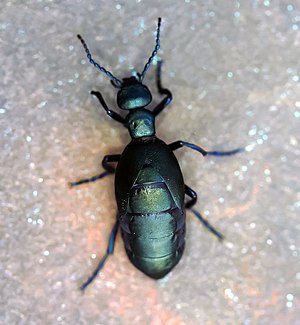Meloe
This article needs additional citations for verification. (November 2013) |
| Meloe | |
|---|---|

| |
| Meloe violaceus | |
| Scientific classification | |
| Kingdom: | Animalia |
| Phylum: | Arthropoda |
| Class: | Insecta |
| Order: | Coleoptera |
| Family: | Meloidae |
| Subfamily: | Meloinae |
| Tribe: | Meloini |
| Genus: | Meloe Linnaeus, 1758 |
| Species | |
|
See text | |
The blister beetle genus Meloe is a large, widespread group commonly referred to as oil beetles.[1] They are known as "oil beetles" because they release oily droplets of hemolymph from their joints when disturbed; this contains cantharidin, a poisonous chemical causing blistering of the skin and painful swelling. Members of this genus are typically flightless, without functional wings, and shortened elytra.
As in other members of the family, they are hypermetamorphic, going through several larval stages, the first of which is typically a mobile triungulin that finds and attaches to a host in order to gain access to the host's offspring. In this genus, the host is a bee, and each species of Meloe may attack only a single species or genus of bees. Though sometimes considered parasitoids, it appears that in general, the Meloe larva consumes the bee larva along with its provisions, and can often survive on the provisions alone; thus they do not truly qualify for this designation (see Parasitoid for definition).
Species
Arranged alphabetically.[2][3][4]
- Meloe afer Bland, 1864
- Meloe ajax Pinto, 1998
- Meloe aleuticus Borchmann, 1942
- Meloe americanus Leach, 1815
- Meloe angusticollis Say, 1824 – short-winged blister beetle
- Meloe barbarus LeConte, 1861
- Meloe bitoricollis Pinto and Selander, 1970
- Meloe brevicollis Panzer, 1793 – short-necked oil beetle
- Meloe californicus Van Dyke, 1928
- Meloe campanicollis Pinto and Selander, 1970
- Meloe carbonaceus LeConte, 1866
- Meloe chinensis Pan & Bologna, 2021
- Meloe dianella Pinto and Selander, 1970
- Meloe distincticornis Pan & Bologna, 2021
- Meloe dugesi Champion, 1891
- Meloe exiguus Pinto and Selander, 1970
- Meloe franciscanus Van Dyke, 1928
- Meloe gracilicornis Champion, 1891
- Meloe himalayensis Pan & Bologna, 2021
- Meloe impressus Kirby, 1837
- Meloe kashmirensis Pan & Bologna, 2021
- Meloe kaszabi Pan & Bologna, 2021
- Meloe laevis Leach, 1815 – oil beetle
- Meloe lateantennatus Pan & Bologna, 2021
- Meloe nebulosus Champion, 1891
- Meloe niger Kirby, 1837
- Meloe occultus Pinto and Selander, 1970
- Meloe orientalis Pan & Bologna, 2021
- Meloe paropacus Dillon, 1952
- Meloe poggii Pan & Bologna, 2021
- Meloe proscarabaeus Linnaeus, 1758 - black oil beetle
- Meloe quadricollis Van Dyke, 1928
- Meloe rugosus Marsham, 1802 - rugged oil beetle
- Meloe shapovalovi Pan & Bologna, 2021
- Meloe strigulosus Mannerheim, 1852
- Meloe tropicus Motschulsky, 1856
- Meloe quadricollis Van Dyke, 1928
- Meloe vandykei Pinto and Selander, 1970
- Meloe variegatus Donovan, 1793
- Meloe violaceus Marsham, 1802
- Meloe xuhaoi Pan & Bologna, 2021
References
- ^ Oil Beetles (Meloe), BugGuide
- ^ Meloe, funet.fi
- ^ Meloe, ITIS Report
- ^ Pan, Zhao; Bologna, M.A. (7 July 2021). "Morphological revision of the Palaearctic species of the nominate subgenus Meloe Linnaeus, 1758 (Coleoptera, Meloidae), with description of ten new species". Zootaxa. 5007: 1–74. doi:10.11646/zootaxa.5007.1.1 – via Mapress.
External links
 Media related to Meloe at Wikimedia CommonsError: "Q133378" is not a valid Wikidata entity ID.
Media related to Meloe at Wikimedia CommonsError: "Q133378" is not a valid Wikidata entity ID.
- Articles with short description
- Short description with empty Wikidata description
- Articles needing additional references from November 2013
- All articles needing additional references
- Articles with 'species' microformats
- Commons category link is defined as the pagename
- Taxonbars desynced from Wikidata
- Taxonbar pages requiring a Wikidata item
- Taxonbars with invalid from parameters
- Taxonbars without secondary Wikidata taxon IDs
- Meloidae
- Tenebrionoidea genera
- All stub articles
- Meloidae stubs
